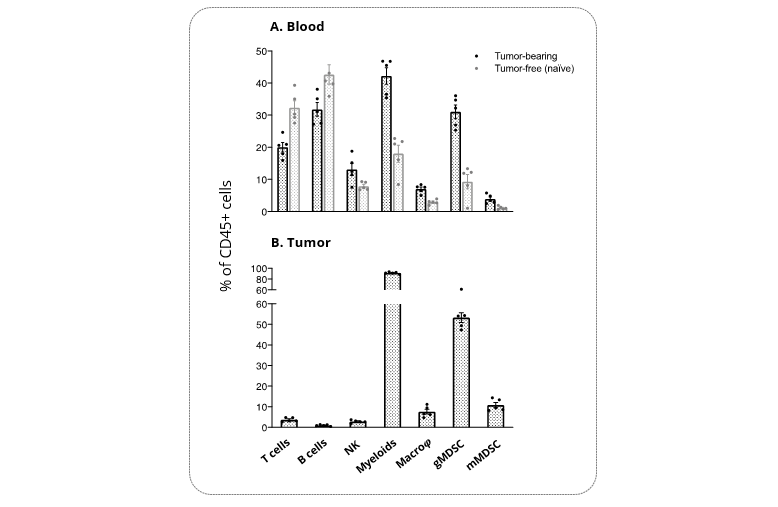Fully set up and characterized syngeneic Lewis LLC1 mouse model featured by (i) a moderate tumor immune infiltration – predominantly constituted of suppressive MDSCs and (ii) accumulation of circulating MDSCs. Interestingly, we showed here that, while LLC1 tumors remain insensitive to PD1 blockade, cyclophosphamide, a reference alkylating anti-cancer agent, led to a tumor growth inhibition and survival rate improvement.
Hence, treatment efficacy optimization and evaluation of novel therapeutic options are increasingly needed, even along with assessment of new tools and/or biomarkers that can aid in early detection of lung cancer and efficacy monitoring.
We have fully set up and characterized a syngeneic Lewis LLC1 mouse model featured by (i) a moderate tumor immune infiltration – predominantly constituted of suppressive MDSCs and (ii) accumulation of circulating MDSCs. Interestingly, we showed here that, while LLC1 tumors remain insensitive to PD1 blockade, cyclophosphamide, a reference alkylating anti-cancer agent, led to a tumor growth inhibition and survival rate improvement.
All these features make the model well-suited tool for preclinical studies of novel therapeutic agents and anti-cancer strategies.
Figure 1: Lewis LLC1 lung tumor model displays a noticeable sensitivity to cyclophosphamide (CPH), while remains non-responsive to PD1 blockade. Individual tumor volume (mm3) (A) and Kaplan-Meier plot survival (B) of LLC1 tumor-bearing mice upon vehicle, CPH, anti-PD1 antibody or combination treatment. While being insensitive to the PD1 blocker, LLC1 tumors are responsive to the alkylating anticancer reference agent, and their response level still offers sufficient dynamic range to evaluate novel combination therapies.
Figure 2: Lewis LLC1 tumor-bearing model is characterized by an abundance of immunosuppressive myeloid cells. Immune cell FACS-based profiling of Lewis LLC1 tumor model shows – mainly – that i) the model is characterized by an increase and decrease of circulating immunosuppressive MDSC and T cells, respectively (A), and that ii) immune cells infiltrating the tumor are overwhelmingly myeloids with a high proportion of granulocytic MDSC (B).
Learn more about the Syngeneic Lewis LLC1 Lung Cancer Mouse Model



